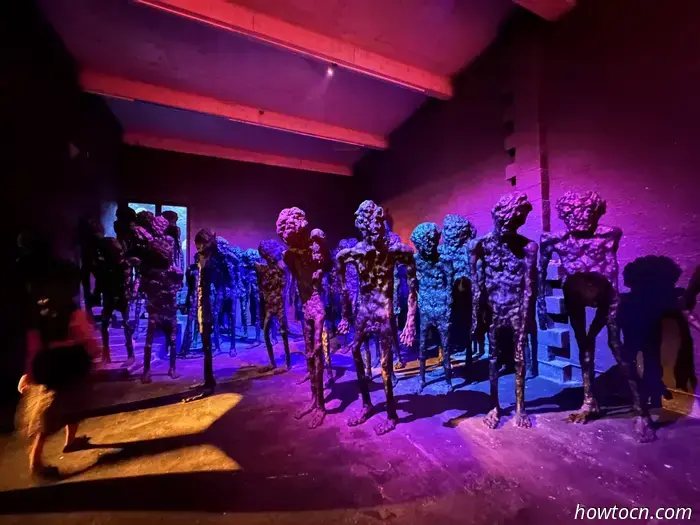
In the far eastern outskirts of Beijing, beyond the expressways and towering buildings, there exists a locale that resembles a village more than a capital city. Courtyards flow into narrow alleys. Walls are adorned with murals, abandoned canvases, and incomplete sculptures left to dry in the sunlight. This place is Songzhuang, the largest artist colony in China—expansive, unkempt, and vibrantly alive.
While the 798 Art District has long been regarded as Beijing's polished emblem of contemporary art, Songzhuang presents a contrasting narrative. Here, artists live and create in the same spaces, far removed from the glare of commercial galleries. For collectors, the appeal lies in the closeness: knocking on studio doors, sipping tea with artists, and discovering works before they hit the market.
Our knowledgeable friend, Wei Lin, an art dealer by passion (and our translator for the day), is intimately familiar with every corner of Songzhuang. He guided us on a tailored exploration through the village, introducing us to artists who generously welcomed us into their homes and studios.
First, we met siblings Bharat Singh and Gurjinder Kaur, both gifted sculptors who traveled from India to China on art scholarships with aspirational dreams. Songzhuang has become their sanctuary, a space for creation, exhibition, and promotion of cross-border art. In their studio filled with towering sculptures and paintings reflecting childhood memories, cultures blended seamlessly alongside one another. Masala chai was served with Chinese mooncakes, and conversation flowed in a dynamic mix of Hindi and Mandarin.
Next, we were received by Anwer Behtiyar and Zulhumar Telet, a Uyghur couple whose home serves dually as a gallery. As contemporary painters, they consider their shared space a canvas for dialogue. Artworks lean against walls, hang from staircases, and spill into corners. Over tea, they discussed their collaborative artistry: two unique voices intertwined by a shared life and workspace. Their home radiated warmth and openness, embodying how Songzhuang facilitates a blend of private and public, personal and professional.
We then visited the studio of Wang Zhe, an elderly painter whose works are displayed in Beijing's National Art Museum. Once highly acclaimed, his reputation precedes him, yet nothing could fully prepare us for his workspace. Every wall teemed with canvases drenched in shades of purple—his trademark color—while brushes, paint tubes, and half-finished sketches cluttered the floor in a creative disarray. Among the chaos, one series stood out: his reinterpretation of Monet's Water Lilies through a uniquely Chinese perspective, glistening with layered textures and a serene calm. The studio felt less like a room and more like stepping into an artist's vibrant, restless mind, still engaged in a conversation between tradition and modernity.
In contrast, Liu Zhengxin, a lithography artist, operates from a vast studio that exuded a near-monastic sense of order. Several rooms opened onto a serene courtyard, each space immaculate—floors spotless, tools neatly organized, not a trace of stray pigment in sight. The atmosphere was disciplined, almost austere, as if precision was the very medium. Liu's art unfolded in black and white, the stark contrasts reflecting the space's clarity. After the clutter of paint-splattered studios and crowded courtyards, Liu's environment felt like entering a realm of stillness—a testament that Songzhuang embodies both restraint and exuberance.
In the evening, sculptor Lin Huixing greeted us at his home, situated amid extensive cornfields. Referring to it as a home almost undersells it; it resembled a personal museum. Three floors and a vast courtyard brimmed with his sculptures, each area carefully illuminated so that they appeared to come alive at night. We dined surrounded by towering figures: human-like forms, slightly distorted, their flaws celebrated rather than hidden. Some leaned, others twisted, some gazed at us with unnerving intensity, challenging us to confront our own vulnerabilities. In that surreal ambiance, dinner transcended mere sustenance; it became an immersion into Lin's universe, where beauty is found not in perfection but in imperfection.
By the time we departed from Songzhuang, it was evident that the colony represents more than just a geographic collection of artists; it is a living experiment in community. Each studio possessed its own rhythm—chaotic, orderly, intimate, or monumental—but together they create a portrait of a village where art and life intertwine.
Songzhuang is significant not only for its scale but also for its spirit. It embodies a vision of contemporary art that prioritizes process, dialogue, and authenticity over spectacle and sales. To outsiders, it may appear chaotic. For collectors, it provides a unique opportunity to engage with artists in their own spaces, amidst the mess and beauty of their everyday lives. For the artists, it remains, against all odds, Beijing's bo







At the extreme eastern edge of Beijing, beyond the highways and skyscrapers, exists a location that resembles a village rather than a major capital.